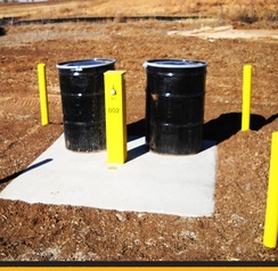Oil and gas drilling has gone on in the Permian Basin since the 1920s. Today, the fastest growing area of gas production involves the use of hydraulic fracking in horizontal wells. This process involves injecting substances into the bedrock surrounding a drill bore to help with extracting oil and gas deposits. This fracking activity happens beneath an impermeable layer of sediment. That layer helps protect groundwater above from contamination. The age of the existing well systems in this region creates the greatest concerns for contamination seeping into the ground water. Monitoring wells help verify the groundwater throughout the Permian Basin remains free of contamination associated with oil and gas drilling operations. These wells watch for and alert when contaminants are found in groundwater. The Permian Basin offers challenges for anyone trying to drill, whether for oil and gas or for monitoring purposes.
What is the Drilling Technology for Installing Monitor Wells?
The choice of drilling technology depends on the depth, lithology, and the size of boring or well at the site.
- Direct Push technology allows for quick, shallow borings to be installed and even small diameter monitor wells in a very cost effective manner.
- Hollow stem drilling offers a solution in areas where the strata are unstable. It allows for a clean bore to the desired level and provides a solid casing around the well to prevent foreign material from entering the well.
- Air rotary drilling allows quick penetration of consolidated bedrock. The biggest challenge with this technology is that in unconsolidated formations the borehole walls can slough causing a “wash-out” and create problems keeping the boring open
- Mud rotary drilling is used in unconsolidated sands and gravels that can create problem in air rotary drilling.
What About Lithology of the Region?
The gas and oil fields of the Permian Basin sit on top of the San Andres dolomite and limestone formations. Above these formations are impenetrable layers of sea salt and potash. All of these layers came from the gradual disappearance of a primordial sea. It is that layer that provides a layer of protection between groundwater and the fracking activities below.
What Are the Contamination Concerns?
Monitor wells are installed to for various reasons. The two most common are to investigate a concern or release to to the groundwater or soil. A contaminant can be anything foreign that poses a harmful risk to the environment. The second most common reason to install a monitor well is to evaluate the quality the media (soil vapor or groundwater) in the well over a certain time period, by collecting samples. Drilling crews take safety precautions when drilling in potential contaminated zones by wearing the appropriate personal protective equipment know as PPE.
What about Site Impact and Restoration?
Installing monitor well can slightly impact the land surface depending on the size of the rig and the drilling technology. All cuttings and debris are containerized and should never touch the surface due to potential contamination concerns. The soil and water removed from the drilling process will need to be stored onsite or an approved staging area until it is profiled to a disposal facility. Once removed the site can be restored to its original condition.
To get the best results, you need to select a professional company with plenty of experience drilling in the Basin. They will know the challenges before hand and have the means to work through just about any issue.
If you need monitoring wells installed, give the environmental drilling experts at Talon/LPE a call today. The company's goal is to give quality environmental drilling services to clients throughout Texas and the surrounding regions.

